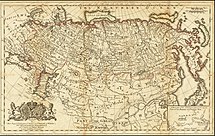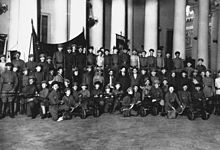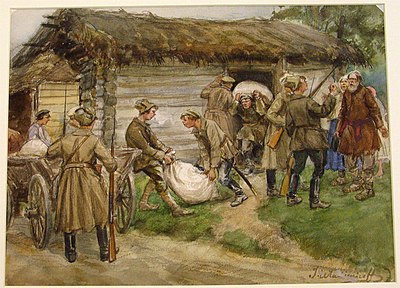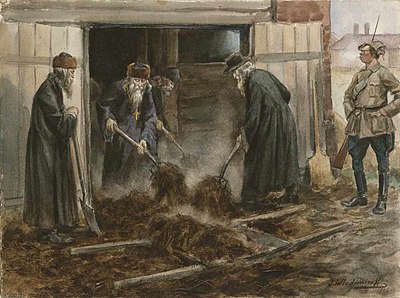History of Soviet Russia and the Soviet Union (1917–1927)
This article needs additional citations for verification. (June 2007) |
| History of Russia |
|---|
 |
|
|
| Part of a series on the |
| History of the Soviet Union |
|---|
 |
|
|
The ten years 1917–1927 saw a radical transformation of the
All politics and attitudes that were not strictly RCP were suppressed, under the premise that the RCP represented the
Russian Revolution of 1917
During World War I, Tsarist Russia experienced military humiliation, famine and economic collapse. The demoralized Imperial Russian Army suffered severe military setbacks, and many captured soldiers deserted the front lines. Dissatisfaction with the monarchy and its policy of continuing the war grew among the Russian people. Tsar Nicholas II abdicated the throne following the February Revolution of 1917 (March 1917 N.S. See: Soviet calendar.), causing widespread rioting in Petrograd and other major Russian cities.
The Russian Provisional Government was installed immediately following the fall of the Tsar by the Provisional Committee of the State Duma in early March 1917 and received conditional support of the Mensheviks. Led first by Prince Georgy Lvov, then Alexander Kerensky the Provisional Government consisted mainly of the parliamentarians most recently elected to the State Duma of the Russian Empire, which had been overthrown alongside Tsar Nicholas II. The new Provisional Government maintained its commitment to the war, remaining in the Triple Entente with Britain and France. The Provisional Government postponed the land reforms demanded by the Bolsheviks.
Lenin, and his Assistant Joseph Stalin embodying the Bolshevik ideology, viewed alliance with the capitalist countries of Western Europe and the United States as involuntary servitude of the proletariat, who was forced to fight the imperialists' war. As seen by Lenin, Russia was reverting to the rule of the Tsar, and it was the job of Marxist revolutionaries, who truly represented socialism and the proletariat, to oppose such counter-socialistic ideas and support socialist revolutions in other countries.
Within the military, mutiny and desertion were pervasive among conscripts. The intelligentsia was dissatisfied over the slow pace of social reforms; poverty was worsening, income disparities and inequality were becoming out of control while the Provisional Government grew increasingly autocratic and inefficient. The government appeared to be on the verge of succumbing to a military junta. Deserting soldiers returned to the cities and gave their weapons to angry, and extremely hostile, socialist factory workers. The deplorable and inhumane poverty and starvation of major Russian centers produced optimum conditions for revolutionaries.
During the months between February and October 1917, the power of the Provisional Government was consistently questioned by nearly all political parties. A system of "dual power" emerged, in which the Provisional Government held nominal power, though increasingly opposed by the Petrograd Soviet, their chief adversary, controlled by the Mensheviks and Socialist Revolutionaries (both democratic socialist parties politically to the right of the Bolsheviks). The Soviet chose not to force further changes in government due to the belief that the February Revolution was Russia's "crowing" overthrow of the bourgeois. The Soviet also believed that the new Provisional Government would be tasked with implementing democratic reforms and pave the way for a proletarian revolution. The creation of a government not based on the dictatorship of the proletariat in any form was viewed as a "retrograde step" in Vladmir Lenin's April Theses. However, the Provisional Government still remained an overwhelmingly powerful governing body.
Failed military offensives in summer 1917 and large scale protesting and riots in major Russian cities (as advocated by Lenin in his Theses, known as the July Days) led to the deployment of troops in late August to restore order. The July Days were suppressed and blamed on the Bolsheviks, forcing Lenin into hiding. Still, rather than use force, many of the deployed soldiers and military personnel joined the rioters, disgracing the government and military at-large. It was during this time that support for the Bolsheviks grew and another of its leading figures, Leon Trotsky, was elected chair of the Petrograd Soviet, which had complete control over the defenses of the city, mainly, the city's military force. Membership of the Bolsehevik party had risen from 24,000 members in February 1917 to 200,000 members by September 1917.[1]

On 24 October, in the early days of the October Revolution, the Provisional Government moved against the Bolsheviks, arresting activists and destroying pro-Communist propaganda. The Bolsheviks were able to portray this as an attack against the People's Soviet and garnered support for the Red Guard of Petrograd to take over the Provisional Government. The administrative offices and government buildings were taken with little opposition or bloodshed. The generally accepted end of this transitional revolutionary period, which will lead to the creation of the Union of Soviet Socialist Republics (USSR) lies with the assault and capture of the poorly defended Winter Palace (the traditional home and symbol of power of the Tsar) on the evening of 26 October 1917.

The Mensheviks and the right-wing of the Socialist Revolutionaries, outraged by the abusive and coercive acts carried out by the Red Guard and Bolsheviks[
Russian Civil War

Prior to the revolution, the Bolshevik doctrine of democratic centralism argued that only a tightly knit and secretive organization could successfully overthrow the government; after the revolution, they argued that only such an organization could prevail against foreign and domestic enemies. Fighting the civil war would actually force the party to put these principles into practice.
Arguing that the revolution needed not a mere parliamentary organization but a party of action which would function as a scientific body of direction, a vanguard of activists, and a central control organ, the Tenth Party Congress banned factions within the party, initially intending it only to be a temporary measure after the shock of the Kronstadt rebellion. It was also argued that the party should be an elite body of professional revolutionaries dedicating their lives to the cause and carrying out their decisions with iron discipline, thus moving toward putting loyal party activists in charge of new and old political institutions, army units, factories, hospitals, universities, and food suppliers. Against this backdrop, the nomenklatura system (a class of people who were granted key positions only with approval of the party) would evolve and become standard practice.
In theory, this system was to be democratic since all leading party organs would be elected from below, but also centralized since lower bodies would be accountable to higher organizations. In practice, "democratic centralism" was centralist, with decisions of higher organs binding on lower ones, and the composition of lower bodies largely determined by the members of higher ones. Over time, party cadres would grow increasingly careerist and professional. Party membership required exams, special courses, special camps, schools, and nominations by three existing members.

In December 1917, the
At the same time, the
, targeted suspected Bolshevik sympathizers.During the Russian civil war the Jewish communities of Ukraine, and to a lesser extent Belarus, suffered the worst


The Soviet government was able gradually to consolidate its hold on central Russia first and then to fight its enemies successfully. The Allied intervention and the Polish invasion allowed the Bolsheviks to play the nationalist card. Worsening economic conditions, however, created mass social turmoil. This came to a head after the final defeat of organised White military forces in the autumn of 1920 with mass peasant insurgencies, such as the Tambov Rebellion. They were brutally suppressed.[5]
Polish–Soviet War
The frontiers between Poland, which had established an
between Poland and Soviet Russia.Creation of the USSR
On 29 December 1922 a conference of plenipotentiary delegations from the
Propaganda and media

Some of the leading Bolsheviks who came to power in 1917 had been pamphleteers or editors, including Lenin, Trotsky, Stalin, Bukharin, and Zinoviev. Lenin set up the daily newspaper Pravda in January 1912. Before it was suppressed by the government in 1914 it was a "singularly effective propaganda and educational instrument which enabled the Bolsheviks to gain control of the Petersburg labour movement and to build up a mass base for their organization."[8] Under Lenin, the Bolsheviks (Communists) controlled all of the media After 1917. The major national newspapers were Izvestia (the voice of the government),[9] and especially Pravda (the voice of the party).[10] Pravda acquired the first and best printing equipment for illustrations.[11] The leading newspapers developed a specialized rhetorical vocabulary designed to enhance the totalitarian structure of society, with total truth emanating from the top, and all sorts of mischievous errors stemming from clumsy bureaucrats at lower levels, or from devious traitors and spies working on behalf of capitalism.[12]
The Communist leadership was rooted in printed propaganda. Taking over a nation where 90% could not read, they made schools and literacy a high priority in order to optimize printed journalism and propaganda through newspapers and magazines, as well as posters that reached the illiterate older generations.[13][14]

The
Radio was not neglected—it was a major new technology, and was used for political speeches. Soviet authorities realized that the "ham" operator was highly individualistic and encouraged private initiative– too much so for the totalitarian regime. Criminal penalties were imposed but the working solution was to avoid broadcasting over the air. Instead radio programs were transmitted by copper wire, using a hub and spoke system, to loudspeakers in approved listening stations, such as the "Red" corner of a factory.[15]
The Soviet style involved citizens listening to party leaders, using in-person speeches, radio talks or printed speeches. There was little role for the journalist to summarize or interpret the text; there was no commentary or background or discussion. No one questioned or challenged the leadership. There were no press conferences and little in the way of broadcast news.[16][17]
Foreign correspondents were strictly prevented from any access beyond official spokesmen. The result was a rosy depiction of Soviet life in the Western media before Khrushchev exposed Stalin's horrors in the 1950s.[18] The most famous exemplar was Walter Duranty of the New York Times.[19][20][21]
War Communism


During the Civil War (1917–21), the Bolsheviks adopted
The
As millions died of starvation, Communist officials were paralyzed by the
New Economic Policy


At the Tenth Party Congress, it was decided to end War Communism and institute the New Economic Policy (NEP), in which the state allowed a limited market to exist. Small private businesses were allowed and restrictions on political activity were somewhat eased.[26]
However, the key shift involved the status of
In the cities and between the cities and the countryside, the NEP period saw a huge expansion of trade in the hands of full-time merchants – who were typically denounced as "speculators" by the leftists and also often resented by the public. The growth in trade, though, did generally coincide with rising living standards in both the city and the countryside (around 80% of Soviet citizens were in the countryside at this point).
Factories, badly damaged by civil war and capital depreciation, were far less productive. In addition, the organization of enterprises into trusts or syndicates representing one particular sector of the economy would contribute to imbalances between supply and demand associated with monopolies. Due to the lack of incentives brought by market competition, and with little or no state controls on their internal policies, trusts were likely to sell their products at higher prices.
The slower recovery of industry would pose some problems for the peasantry, who accounted for 80% of the population. Since agriculture was relatively more productive, relative price indexes for industrial goods were higher than those of agricultural products. The outcome of this was what Trotsky deemed the "Scissors Crisis" because of the scissors-like shape of the graph representing shifts in relative price indexes. Simply put, peasants would have to produce more grain to purchase consumer goods from the urban areas. As a result, some peasants withheld agricultural surpluses in anticipation of higher prices, thus contributing to mild shortages in the cities. This, of course, is speculative market behavior, which was frowned upon by many Communist Party cadres, who considered it to be exploitative of urban consumers.
In the meantime, the party took constructive steps to offset the crisis, attempting to bring down prices for manufactured goods and stabilize inflation, by imposing price controls on essential industrial goods and breaking-up the trusts in order to increase economic efficiency.
Death of Lenin and the fate of the NEP
Following Lenin's third stroke, a
Zinoviev and Nikolai Bukharin became concerned about Stalin's increasing power and proposed that the Orgburo which Stalin headed be abolished and that Zinoviev and Trotsky be added to the party secretariat thus diminishing Stalin's role as general secretary. Stalin reacted furiously and the Orgburo was retained but Bukharin, Trotsky and Zinoviev were added to the body.
Due to growing political differences with Trotsky and his Left Opposition in the fall of 1923, the troika of Stalin, Zinoviev and Kamenev reunited. At the Twelfth Party Congress in 1923, Trotsky failed to use Lenin's Testament as a tool against Stalin for fear of endangering the stability of the party.
Lenin died in January 1924 and in May his Testament was read aloud at the Central Committee but Zinoviev and Kamenev argued that Lenin's objections had proven groundless and that Stalin should remain General Secretary. The Central Committee decided not to publish the testament.
Meanwhile, the campaign against Trotsky intensified and he was removed from the position of
In 1925, the Soviet Union occupied the island of Urtatagai, which was considered Afghan territory at the time, due to the island being used as a base to start border raids by the Basmachi movement. In 1926 the Soviet Union withdrew from the island after the Kingdom of Afghanistan agreed to restrain the Basmachi.[27]
With the resignation of Trotsky as People's Commissar for Military and Naval Affairs, the unity of the troika began to unravel. Zinoviev and Kamenev again began to fear Stalin's power and felt that their positions were threatened. Stalin moved to form an alliance with Bukharin and his allies on the right of the party who supported the
Trotsky, Zinoviev and Kamenev formed a
Stalin now moved against Bukharin by appropriating Trotsky's criticisms of his right wing policies and he promoted a new general line of the party favoring collectivization of the peasantry and rapid industrialization, forcing Bukharin and his supporters into the Right Opposition.
At the Central Committee meeting held in July 1928, Bukharin and his supporters argued that Stalin's new policies would cause a breach with the peasantry. Bukharin also alluded to Lenin's Testament. While he had support from the party organization in Moscow and the leadership of several commissariats, Stalin's control of the secretariat was decisive in that it allowed Stalin to manipulate elections to party posts throughout the country, giving him control over a large section of the Central Committee. The Right Opposition was defeated and Bukharin attempted to form an alliance with Kamenev and Zinoviev but it was too late.
Nationalities

The Russian Empire comprised a multitude of nationalities, languages, ethnic groups and religions. The spirit of nationalism, so strong in 19th century Europe, was significant in Russia, Ukraine, and Finland especially before 1900. Much later the spirit of nationalism appeared in central Asia, especially among the Muslim population.[28] The Bolsheviks made use of the slogan "Self-determination" to fight imperialism and to build support among non-Russian nationalities.[29] Lenin's position was that after the revolution all nationalities would be free to choose, either to become part of Soviet Russia or become independent.[30] Left-wing Bolsheviks, most notably Georgy Pyatakov, derided nationalism as a false consciousness that was much less important than class conflict, and would disappear with the victory of socialism.
Lenin's views prevailed, and were supported by Stalin, who became the Party's specialist on nationalities. The "Declaration of the Rights of the Peoples of Russia", issued 15 November 1917, left the new Soviet state with undefined boundaries, and invited of other nations to join in. The "Declaration of the Rights of the Toiling and Exploited People", issued in January 1918, announced that all nationalities would have the right to determine on what basis they would participate in the federal government of the new state. A new agency was set up, the People's Commissariat for Nationalities (NARKOMNATS) based in Moscow. It operated from 1918 to 1924 and had responsibility for 22 percent of the entire Soviet population. It was led by Stalin and settled boundary disputes as it set up autonomous regions for non-Russian peoples. It established newspapers in the local languages and fostered literacy. It took a paternalistic view toward "backward" or "primitive peoples". Soviet anthropology and ethnography specialized in understanding these people.[31] Evkom was the Jewish Commissariat;[32] Muskom was the Muslim Commissariat.[33][34][35]
See also
- Foreign relations of the Soviet Union
- History of Russia
- Timeline of Russian history
- Historiography in the Soviet Union
- Leninism
- Politics of the Soviet Union
- Political repression in the Soviet Union
References
- ^ Stephen Cohen, Bukharin and the Bolshevik Revolution: A Political Biography 1888–1938 (Oxford University Press: London, 1980) p. 46.
- ISBN 9781317863687.
- ISBN 978-0-253-33333-9.)
{{cite book}}:|last=has generic name (help)CS1 maint: multiple names: authors list (link - ^ Crimes and Mass Violence of the Russian Civil Wars (1918-1921)
- ^ International Responses to the Russian Civil War (Russian Empire)
- ^ (in Russian) Voted Unanimously for the Union Archived 4 December 2009 at the Wayback Machine
- ^ (in Russian) Creation of the USSR Archived 29 May 2007 at the Wayback Machine at Khronos.ru
- ^ Whitman Bassow, "The Pre-Revolutionary Pravda and Tsarist Censorship," American Slavic and East European Review (1954) 13#1 pp. 47–65 in JSTOR
- ^ John C. Merrill, and Harold A. Fisher, The world's great dailies: profiles of fifty newspapers (1980) pp 170–76
- ^ Merrill, and Fisher, The world's great dailies: profiles of fifty newspapers (1980) pp 242–49
- ^ Katerina Romanenko, "Photomontage for the Masses: The Soviet Periodical Press of the 1930s." Design Issues 26.1 (2010): 29–39.
- ^ Ludmila Pöppel, "The rhetoric of Pravda editorials: A diachronic study of a political genre." (Stockholm U. 2007). online
- ^ Boris N. Mironov, "The Development of Literacy in Russia and the USSR from the Tenth to the Twentieth Centuries." History of Education Quarterly 31.2 (1991): 229–252 in JSTOR.
- ^ Ben Eklof, "Russian literacy campaigns, 1861–1939." in Harvey J. Graff and Robert F. Arnove, eds., National Literacy Campaigns and Movements: Historical and Comparative Perspectives (Springer US, 1987) pp. 123–145.
- ^ Stephen Lovell, "How Russia learned to listen: radio and the making of Soviet culture." p 600-1
- ^ Stephen Lovell, "Broadcasting Bolshevik: The radio voice of Soviet culture, 1920s–1950s." Journal of Contemporary History 48.1 (2013): 78–97.
- ^ Jeffrey Brooks, "Public and private values in the Soviet press, 1921–1928." Slavic Review 48.1 (1989): 16–35.
- ^ Whitman Bassow, Moscow Correspondents: From John Reed to Nicholas Daniloff (1988).
- ^ Sally J. Taylor, Stalin's Apologist: Walter Duranty: The New York Times's Man in Moscow (Oxford UP, 1990).
- ^ R. B. Cockett, "'In Wartime Every Objective Reporter Should Be Shot.'The Experience of British Press Correspondents in Moscow, 1941-5." Journal of Contemporary History 23#4 (1988): 515–530. in JSTOR
- ^ Ralph Elphick, "Moscow's blue pencils and the green baize door," Historical Journal of Film, Radio & Television (2004) 24#3 pp 491–495. Elphick was a Reuters correspondent in Moscow 1958–62.
- ^ Alan M. Ball,Russia's Last Capitalists: The Nepmen, 1921–1929 (U of California Press, 1990) online free pp 10–38.
- ISBN 978-0-19-913425-0.
- ISBN 9780307788610.
- ^ Charles M. Edmondson, "The politics of hunger: The Soviet response to famine, 1921." Soviet Studies 29.4 (1977): 506–518. online
- ^ Alan M. Ball, Russia's Last Capitalists: The NEPmen, 1921–1929. (U of California Press, 1987). online free
- S2CID 159486304.
- ^ James R. Millar, Encyclopedia Of Russian History (2004) 3: 1000–1027.
- ^ Rudolf A. Mark, "National Self-Determination, as Understood by Lenin and the Bolsheviks." Lithuanian Historical Studies (2008), Vol. 13, p 21-39. Online[permanent dead link]
- ^ Alfred D. Low, Lenin on the Question of Nationality (1958) pp 130–39. Online
- ^ Greenwood Press 1995, p.20.
- ^ Zvi Y. Gitelman, Jewish Nationality and Soviet Politics: The Jewish Sections of the CPSU, 1917–1930 (1972)
- ^ Millar, Encyclopedia 3:1158–59.
- ^ Jeremy Smith, "Stalin as Commissar for Nationality Affairs, 1918–1922,: in Sarah Davies, ed., Stalin: A new history (2005), pp 45–62 DOI: https://doi.org/10.1017/CBO9780511614897.006
- ^ Stephen Blank, The Sorcerer as Apprentice: Stalin as Commissar of Nationalities, 1917 – 1924 (1994) Online
Further reading
- Acton, Edward, V. I͡U Cherni͡aev, and William G. Rosenberg, eds. Critical companion to the Russian Revolution, 1914–1921 (Indiana UP, 1997), emphasis on historiography
- Ball, Alan M. Russia's Last Capitalists: The NEPmen, 1921–1929. (U of California Press. 1987). online free
- Cohen, Stephen F. Rethinking the Soviet Experience: Politics and History since 1917. New York: Oxford University Press, 1985.
- Daniels, Robert V. "The Soviet Union in Post‐Soviet Perspective" Journal of Modern History (2002) 74#2 pp: 381–391. in JSTOR
- Davies, R. W. ed. From Tsarism to the New Economic Policy: Continuity and Change in the Economy of the USSR. (Cornell UP, 1991)
- Fitzpatrick, Sheila, et al. eds. Russia in the Era of NEP. (1991).
- Fitzpatrick, Sheila. The Russian Revolution. New York: Oxford University Press, 1982, 208 pages. ISBN 0-19-280204-6
- Hosking, Geoffrey. The First Socialist Society: A History of the Soviet Union from Within (2nd ed. Harvard UP 1992) 570pp
- Gregory, Paul R. and Robert C. Stuart, Russian and Soviet Economic Performance and Structure (7th ed. 2001)
- Kort, Michael. The Soviet Colossus: History and Aftermath (7th ed. 2010) 502pp
- Kotkin, Stephen. Stalin: Paradoxes of Power, 1878–1928 (2014), scholarly biography
- Kotkin, Stephen. Stalin vol 2 1929–1941 (2017)
- Lincoln, W. Bruce. Passage Through Armageddon: The Russians in War and Revolution, 1914–1918 (1986) online
- Lewin, Moshe. Russian Peasants and Soviet Power. (Northwestern University Press, 1968)
- McCauley, Martin. The Rise and Fall of the Soviet Union (2007), 522 pages.
- Millar, James R. ed. Encyclopedia of Russian History (4 vol, 2004), 1700pp; 1500 articles by experts.
- Moss, Walter G. A History of Russia. Vol. 2: Since 1855. 2d ed. Anthem Press, 2005.
- Nove, Alec. An Economic History of the USSR, 1917–1991. 3rd ed. London: Penguin Books, 1993. online
- Pipes, Richard. Russia under the Bolshevik regime (1981). online
- Pipes, Richard. The Russian Revolution (1991) online
- Pipes, Richard. A Concise History of the Russian Revolution (1996), abridged version online
- Remington, Thomas. Building Socialism in Bolshevik Russia. (U of Pittsburgh Press, 1984).
- Service, Robert. A History of Twentieth-Century Russia. 2nd ed. Harvard UP, 1999. online
- Service, Robert, Lenin: A Biography (2000) online
- Service, Robert. Stalin: A Biography (2004), along with Kotlin & Tucker a standard biography online
- Tucker, Robert C. Stalin as Revolutionary, 1879–1929 (1973); Stalin in Power: The Revolution from Above, 1929–1941. (1990) online edition with Service, a standard biography; online at ACLS e-books
Primary sources
- Degras, Jane T. The Communist International, 1919–43 (3 Vols. 1956); documents; online vol 1 1919–22; vol 2 1923–28 (PDF).
- Degras, Jane Tabrisky. ed. Soviet documents on foreign policy (1978).
- Eudin, Xenia Joukoff, and Harold Henry Fisher, eds. Soviet Russia and the West, 1920–1927: A Documentary Survey (Stanford University Press, 1957) online
- Eudin, Xenia Joukoff; North, Robert Carver, eds. Soviet Russia and the East, 1920–1927; a documentary survey (Stanford University Press, 1957) online
- Goldwin, Robert A., Gerald Stourzh, Marvin Zetterbaum, eds. Readings in Russian Foreign Policy (1959) 800pp; online; long essays from primary and secondary sources
- Gruber, Helmut. International Communism in the Era of Lenin: A Documentary History (Cornell University Press, 1967)



